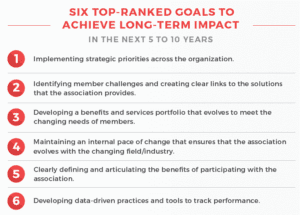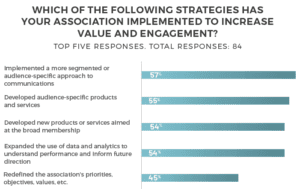Expanding on findings from the 2019 Economic Impact on Associations (EIA) Study, our latest special report goes beyond the strong performance trends and mixed perceptions we covered and provides insights into how associations are responding. With a spotlight on strategy, value and engagement, we took a closer look at:
- Associations’ top priorities and the actions that support them
- Defining and tracking value and engagement
- The membership model of the future
Translating priorities to action
This year shows an increased emphasis on strategic planning (up 10% from 2018) with a shift away from generating non-dues revenue (down 10% from 2018). What hasn’t changed? A focus on engagement. Associations continue to seek ways to make the membership experience as compelling as possible, and customization is often the approach they take to achieve that goal.

While we can learn a lot from what association executives rank high in importance, we also gained important insights based on lower rankings. Unfortunately, we discovered that relatively few associations are embracing approaches that reflect adaptation. This includes cross-organizational and cross-team work, workplace automation, ensuring a high-functioning governance structure and realizing greater diversity and inclusion. In our work with a broad range of associations, we find that these areas are often at the root of broader organizational challenges and limitations.
Defining and tracking value and engagement
Although frequently referenced in the association community, the words “value” and “engagement” lack clear definition. To gain clarity on interpretation, we asked: “What separates an association that provides true value to members versus one that does not provide much value?” Survey respondents shared common themes, including:
- More explicit links between member challenges and association solutions (i.e., benefits and services).
- A benefits portfolio that evolves to meet changing member needs — particularly around career development.
- Highly customized products and communications that reflect the unique needs of specific audiences.
Elaborating on this, we asked respondents how they view engagement. Ninety-six percent labeled it a priority, with 61% of professional associations and 53% of trades considering it their “top or most important priority.” We took a closer look at how this is applied to everyday action and found that the two lowest-ranked strategies were those cited as having the greatest impact — an indication that associations might be focusing their attention in areas that have less impact, or at least less measurable impact.

The membership model of the future
Based on observations of current priorities and activities, we forecasted the trajectory of association value and engagement models. Our predictions included several transformations, including:
- Flexibility in participation and commitment
- Customized benefits
- A market-driven approach to product development and refinement
- Automating key functions for a better customer experience
- Internal collaboration
- And more
One size doesn’t fit all
Operating within complex and often unpredictable environments, associations seek best practices, data and proven solutions to increase their likelihood of success. But our findings confirm there is no universal fix. Instead, what we see is that the most successful associations invest in building strong relationships; are highly aware of current and emerging trends; are willing to take risks; and they maintain a commitment to constant and sustained stakeholder feedback. Learn more about our findings and explore more resources in our special report.
Download Part II of the 2019 EIA Study
Tag(s):
McKinley Advisors
Governance and Leadership
4 min read
| March 7, 2024
Maintaining motivation and persistence in DEIAB work
Read More
Governance and Leadership
3 min read
| February 15, 2024
2024 Association Partner of the Year: Jay Younger
Read More
Governance and Leadership
5 min read
| January 30, 2024






